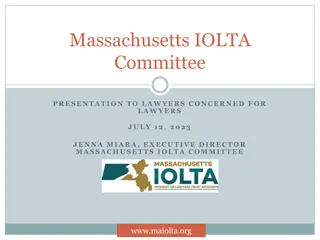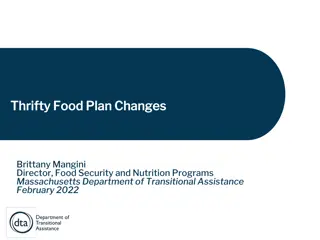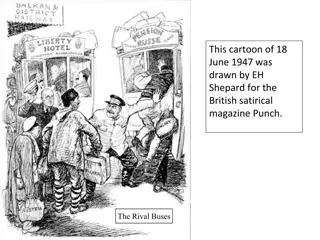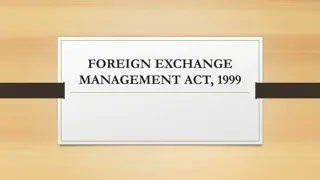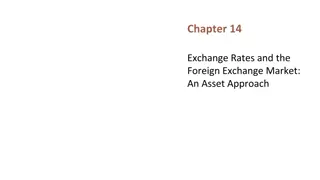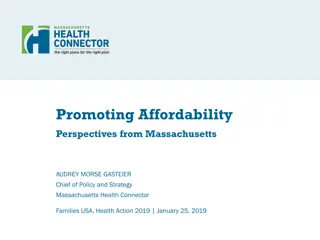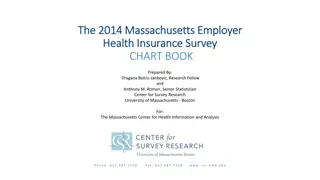
Lessons from Massachusetts Health Insurance Exchanges
Discover valuable insights from research on Massachusetts' health insurance exchange, highlighting the importance of subsidies, affordability, and narrow networks for improving insurance exchanges. Uncover how premium variations impact insurance demand and learn about the impact of hospital networks on adverse selection.
Download Presentation

Please find below an Image/Link to download the presentation.
The content on the website is provided AS IS for your information and personal use only. It may not be sold, licensed, or shared on other websites without obtaining consent from the author. If you encounter any issues during the download, it is possible that the publisher has removed the file from their server.
You are allowed to download the files provided on this website for personal or commercial use, subject to the condition that they are used lawfully. All files are the property of their respective owners.
The content on the website is provided AS IS for your information and personal use only. It may not be sold, licensed, or shared on other websites without obtaining consent from the author.
E N D
Presentation Transcript
Lessons from Massachusetts for Health Insurance Exchanges Mark Shepard Harvard Kennedy School and NBER Wharton Health Insurance Exchange Conference September 2017
Introduction With ACA repeal and replace on ice, increasing interest in practical reforms to improve insurance exchanges Need for research to understand market realities and tradeoffs This talk:Lessons from research on Massachusetts exchange Created in 2006 Romneycare reform Similar design and low-income population as ACA exchanges Key factor: Good data (linked enrollment and claims) + Processes for making available to researchers Two lessons: Subsidies and affordability matter (a lot) 1. Narrow networks have a (selection) advantage 2.
Paper #1: Subsidies and Insurance Demand (Available as NBER Working Paper #23668)
Massachusetts Subsidy/Premium Discontinuities 400 Insurer Price 300 $ per month Public Subsidies 200 5% of income 4% of income $116 100 3% of income $77 Enrollee Premium Affordable Amt. (cheapest plan) $39 $0 0 135 150 200 250 300 Income, % of Poverty
Share of Eligible Population Buying Insurance 94% 1 76% .8 58% .6 70% .4 56% % = -26% 44% % = -27% .2 % = -24% Pmin=$0 Pmin = $39 Pmin = $116 Pmin = $77 0 135 150 200 Income, % of Poverty 250 300
Summary and Take-Aways Modest premiums are major barrier to universal coverage Each ~$40 / month premium increase reduces take-up by ~25% Result: Take-up is highly incomplete (avg. = 63%) True despite: Coverage mandate in MA, generous benefits (AV > 95%), and lower premiums than ACA (0-5% of income, vs. 2-10% in ACA) Marginal enrollees are lower-cost Enrollees deterred by higher premiums are 10-50% lower cost than avg. Implication: Bigger subsidies mean lower average cost of enrolled pop. Effect can be quite large: Decreasing premiums from $39 to $0 lowered average costs by $30-50 / month
Paper #2: Hospital Networks and Adverse Selection (Available as NBER Working Paper #22600)
Narrow Networks and Selection Narrow network plans are the norm in ACA exchanges [McKinsey, Polsky et al. (Penn LDI data), many others] Particularly likely to exclude academic medical centers (McKinsey) Two potential reasons narrow network plans may thrive: 1. Cost reduction: Negotiate discounts, steer patients to lower-cost settings 2. Favorable selection: Avoid high-cost consumers Evidence from MA exchange plans coverage of star Partners Healthcare System (MGH, Brigham & Women s) 2012 case study: Large plan drops Partners from network
Evidence of Selection: Plan Switching RAdj. Cost = $6,852 RAdj. Cost = $4,340 RAdj. Cost = $3,318
Evidence of Cost Reductions: Non-Switchers Cost = -14% Note: Points are group x time coeffs. from regression with individual fixed effects.
Summary and Take-Aways Excluding star hospitals benefitted plan both through cost reduction and favorable selection (about 50/50 magnitude) Risk adjustment did not offset the favorable selection Patients loyal to star hospitals tended to be unobservably sicker and high-cost because of their high-price care Implication: Plans excluding star providers may have special advantage in exchanges Mass.: All but one ConnectorCare exchange plan now excludes Partners Policy implications less clear Changes to encourage coverage may exacerbate star hospital bargaining power



